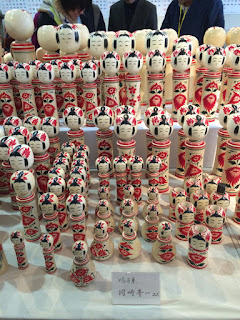We are continuing our vacation in the eastern US, and as I was looking through my mother's kokeshi collection I was delighted to find today's example -- a beautiful Togatta kokeshi 遠刈田系 by Mr. Sato Yasuhiro 佐藤康広さん of Sendai City in Miyagi Prefecture 宮城県. Mr. Sato is a fairly young craftsman who only finished his apprenticeship a few years ago under his father, master craftsman Mr. Sato Masahiro 佐藤正廣さん. We visited the Sato's workshop during a big kokeshi adventure to northeastern Japan back in April 2012, so we know exactly where these kokeshis are made -- here's a link to the entry about our trip to see the Satos.
If my memory is correct about the date when we purchased this kokeshi as a present for my mother -- December 2011 -- it would be one of Yasuhiro's earlier pieces as an independent craftsman. Nonetheless, even at this time we can see his obvious talent for creating clean, smooth and very attractive Togatta kokeshis that have become very famous lately thanks to his indigo blue kokeshis that were on exhibit in Tokyo last year.
Togatta kokeshis, like Naruko kokeshis, are very archetypal in the sense that when one thinks of a traditional kokeshi this is probably the shape and design that they are thinking of. But within the Togatta framework there is great variety; for instance of how the face is painted. And it's here that I believe we can distinguish the Sato family's work. In particular the eyes are very long and crescent-shaped with the nose placed lower than the eyes rather than between them. Looking from straight on the hair design is pushed back to the edges allowing the facial features to dominate. Whether or not what I have described is exclusive to the Satos I cannot say, but as soon as I saw this kokeshi on the shelf I knew whose work I was looking at.
In the above photo we see a close-up view of the body design done with red and green brush strokes. It has a pleasant yet unfamiliar floral pattern that I need to learn more about.
If my memory is correct about the date when we purchased this kokeshi as a present for my mother -- December 2011 -- it would be one of Yasuhiro's earlier pieces as an independent craftsman. Nonetheless, even at this time we can see his obvious talent for creating clean, smooth and very attractive Togatta kokeshis that have become very famous lately thanks to his indigo blue kokeshis that were on exhibit in Tokyo last year.
Togatta kokeshis, like Naruko kokeshis, are very archetypal in the sense that when one thinks of a traditional kokeshi this is probably the shape and design that they are thinking of. But within the Togatta framework there is great variety; for instance of how the face is painted. And it's here that I believe we can distinguish the Sato family's work. In particular the eyes are very long and crescent-shaped with the nose placed lower than the eyes rather than between them. Looking from straight on the hair design is pushed back to the edges allowing the facial features to dominate. Whether or not what I have described is exclusive to the Satos I cannot say, but as soon as I saw this kokeshi on the shelf I knew whose work I was looking at.
In the above photo we see a close-up view of the body design done with red and green brush strokes. It has a pleasant yet unfamiliar floral pattern that I need to learn more about.
A view from the top down reveals an intricate series of brush strokes typical of Togatta kokeshis.
Finally, this photo shows Yasuhiro's signature on the bottom. As mentioned in the previous blog Sato is a really common family name among kokeshi craftsmen, so it may be the case that it's pointless to write Sato on the bottom. Also, I'm pretty impressed with the price since 1,200 yen seems like a real bargain for such a beautiful little piece of hand-crafted art.
Oh, and I might as well direct whoever reads this blog entry to the Sato's web site (click here -- Japanese only) for more information plus a map to their workshop west of downtown Sendai.
























































